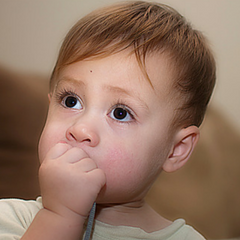
Tips on how to Stop Children with Autism Chewing on Clothes
We've all been there. It's Friday morning. Laundry day. As we load the jumpers and shirts into the drum, we notice the stains on the material and the soggy cuffs. While not uncommon behaviour, it does beg the question "why do children with autism like to chew?"
Self-stimulatory behaviours (or "stimming") is prevalent in many special needs children, mostly appearing in children with autism. Stimming occurs when the need to relieve distress, reduce anxiety, or to combat sensory overload arises.
Stimming can take form in a multitude of ways. Typically these actions fall into six categories; visual, auditory, physical touching, fidgeting, smell, or through taste. The latter form is the most common trait.
Many children with autism will put objects in their mouths, such as pencils or toys, and chew on them as a form of self-stimulatory behaviour. Another habit is sucking shirt sleeves or biting clothes. Although this compulsion is not particularly dangerous, it will lead to dirty jumpers and soggy cuffs!

Stimming, when guided in the right direction, is a fantastic way for the individual to manage challenging and stressful situations. When it comes to biting and chewing, attempting to prevent the action altogether is not practical, nor is it necessary. As long as the actions taken are safe and not causing any damage or harm, there are options to support this behaviour without the cost of damaged clothes.
So how do you stop children with autism chewing on clothing? Here are our top three tips.
Give your child something different to chew
The primary cause of concern around clothes chewing is the risk of dental issues as well as the fact that continuous chewing ruins clothing and end up being quite costly. The first replacement activity to encourage is giving your child something else to chew. Sensory chew toys are a great way to provide a safer outlet for oral stimulation redirecting inappropriate chewing habits from items that you do not want them to be chewing.
Consider adaptive clothing for children
Specialist bodysuits and other autism friendly clothing are fantastic tools to help parents prevent stimming. Short sleeved discreet body suits can limit the access a child has to put the clothing in their mouths. By having tag-free, short sleeved garments, restricting access to the bottom of the shirts, you remove the option to chew. When tied in with other behaviour changing activities, you can limit and influence what your child uses to stim; allowing them to do so in a safe way, working towards helping them stop completely in their own time.
Replace chewing with alternative activities

The desire to chew as a form of stimming may never subside. However, alongside substituting clothing for other objects, another alternative is interchanging the oral stimulation with a different activity that replaces the chewing, but cannot be done at the same time. Activities such as blowing through a straw onto paint to create art, blowing bubbles through a wand, making noises, seeing who can pull the funniest face in a mirror, singing along to their favourite music, or reading a book out loud are all oral activities you can encourage instead of chewing.
You can develop discreet replacements to the habit of chewing on clothing by using a combination of these listed methods. Long-term, by working with your child you can understand why they rely on self-stimulatory behaviours. Gradually you can help them feel more secure within their environment without feeling the need to stim.
SpecialKids.Company stock a variety of adaptive clothing for children with various sensory issues, shop the full range here.

